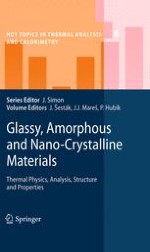
2011 | OriginalPaper | Buchkapitel
1. Introduction: Some Essential Attributes of Glassiness Regarding the Nature of Non-crystalline Solids
verfasst von : Hiroshi Suga
Erschienen in: Glassy, Amorphous and Nano-Crystalline Materials
Verlag: Springer Netherlands
Aktivieren Sie unsere intelligente Suche, um passende Fachinhalte oder Patente zu finden.
Wählen Sie Textabschnitte aus um mit Künstlicher Intelligenz passenden Patente zu finden. powered by
Markieren Sie Textabschnitte, um KI-gestützt weitere passende Inhalte zu finden. powered by